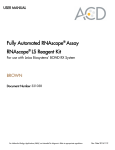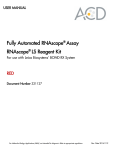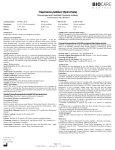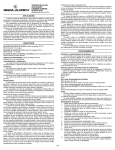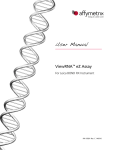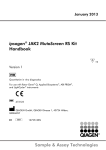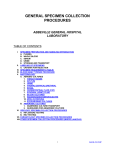Download Chapter 32 Troubleshooting Procedure for ArtisanLink Special
Transcript
Automating Special Stains using Artisan™ and ArtisanLink Special Staining System Chapter 32 Troubleshooting Procedure for ArtisanLink Special Staining System Debra Cobb, HT, MBA The special stains that are available for the ArtisanLink Special Suggested Reading Staining System include: White PI (2007). World Congress of Pathology Informatics. Brisbane, Australia. Acid-Fast Bacteria (AFB) Stain/ Alcian Blue Stain pH 2.5 Ziehl-Neelsen Stain Automation in histology is here to stay. With the shortage of Troubleshooting Issues experienced histotechnologists, an increased workload, and When troubleshooting ArtisanLink Special Staining System, the demands for faster turnaround times, laboratories are looking for ways to produce consistent, quality-stained slides with less staffing histotechnologist will not only be required to rely on his/her knowledge of histology procedures and special stains chemistry, but also on his/ Alcian Blue/PAS Stain Gram Stain in the most efficient time. Iron Stain Alcian Blue/PAS The arrival of automated instruments has forced histotechnologists ArtisanLink software. Because the instrument applies reagents as to familiarize themselves with hardware, software and chemistry in well as heats and incubates according to the instructions given by the order to adequately troubleshoot automated platforms. Understanding user, it is important that the user programs the instrument properly (PAS-M) Stain/ the differences and the similarities between manual and automated taking into consideration that all other processes such as grossing, Mucicarmine Stain special staining is half the battle when it comes to troubleshooting. sectioning, fixation, etc are optimized before the sample is placed Hematoxylin Stain Jones’ Basement Membrane Congo Red Stain her computer skills in order to optimize staining protocols using the on the instrument. In other words, how to optimize individual slides Elastic Stain PAS-Green Stain Periodic Acid-Schiff (PAS) Stain Giemsa Stain Grocott’s Methenamine Silver Reticulin/No Counterstain Every histotechnologist understands that to achieve quality staining results performed manually the following basic factors should be in place in the laboratory: (GMS) Stain Gomori’s Trichrome Stain Back to Basics The most common staining issues on ArtisanLink are: Staining artifacts Background staining Masson’s Trichrome (TRI) Stain 1.Proper grossing, infiltration of tissue with fixative, and dehydration steps. Gomori’s Green Trichrome Stain based on prestaining processes can only be defined by a user. Warthin Starry Stain Feulgen Stain 2.A certain tissue thickness recommended for a particular procedure. For instance, it is recommended to cut tissue for staining with Congo Red into a thickness of 8 µm and tissue for staining with Jones’ Basement Membrane Stain is recommended to be cut Conclusion into a thickness of 2 µm. In conclusion, the ArtisanLink Special Staining System provides 3.Drying slides at the right temperature because drying slides at the flexibility of manual staining coupled with the precision and temperatures above 62° C can cause damage to the tissue leading consistency of automation. Unlike the manual method, there is no to a suboptimal staining. mixing or monitoring of time dependent reaction steps. Furthermore, The same basic factors are required for staining slides on an chemical hazards from mixing of reagents are eliminated and the automated instrument such as ArtisanLink. However, two more variability of special stains results is greatly reduced. Last, but not factors should be taken into consideration: least, the instrument allows the histotechnologist to perform other tasks while the slides are stained. The new ArtisanLink Special Staining System also allows one instrument to communicate with two more instruments with specialized software. Inconsistent staining Staining Artifacts Problem: (1)Tissue slides stored for long periods of time (months to years). (2)Dust particles settling on slides, especially, those that are charged. (3)Dispensing of reagents from dirty bulk liquid containers (Fig. 1). Solution: (1) For slides that may be dusty, it is recommended to try the following procedure after the deparaffinization and hydration steps: Place the slides in running tap water for 2-3 minutes. (a)The user must follow the procedures and instructions as provided by the instrument manufacturer. (b)The user must follow a daily maintenance procedure in addition to the biannual or annual preventive maintenance procedure. Rinse in deionized water. Place the slides in Artisan™ Wash Solution for 5 minutes before loading them on ArtisanLink. (2) For slides that have dispensing artifacts, it is recommended to use clean bulk liquid containers. 266 | special stains and h & E special stains and H & E | 267 Troubleshooting Procedure for ArtisanLink Special Staining System Troubleshooting Procedure for ArtisanLink Special Staining System Figure 1. Artifacts on slides caused by Figure 3a. Nuclear Fast Red precipitate. dirty bulk liquid containers. Figure 3b. Crystal Violet showing shards. Reagent packs that are placed on the instrument need to be checked for any type of build-up of chemical deposits that can be dispensed on the slide during the staining run. It is recommended to check the dispenser tip and to mix and prime the packs before daily use (Fig. 2). It is also important to store the reagent packs tip down to prevent damage to the dispenser’s internal parts. Staining artifacts may also arise from reagent dyes. Dyes such as Nuclear Fast Red or Crystal Violet are known to cause artifacts. For instance, Nuclear Fast Red is sensitive to cold. If the reagent is stored in the refrigerator or left out on the loading dock in freezing weather, there is a risk that the reagent will start to precipitate. Once this reaction starts, it will continue regardless of correcting the storage temperature. This precipitate will then be dispensed onto the slide (Fig. 3a). Crystal Violet is another example of a dye that has a tendency to leave crystal-like shards on the tissue (Fig. 3b). Figure 2. Dispenser showing build-up of chemical deposits. 268 | special stains and h & E special stains and H & E | 269 Troubleshooting Procedure for ArtisanLink Special Staining System Troubleshooting Procedure for ArtisanLink Special Staining System Reagents used on ArtisanLink have been validated and optimized for Background Staining Inconsistent Staining Reagent packs not primed before use. This can cause either a staining quality as well as for correct storage and usage temperatures. Background staining is a common problem when using charged This may be caused due to: non-dispense of reagent or an incomplete dispense of reagent. It It is important that the user follows the recommended temperature slides or when there are additives in the water bath or by heat. When for storage and usage for each of the staining kits. All ArtisanLink using a methenamine silver solution, a “mirroring” also know as grey staining kits have been validated to be used at room temperature. haze can occur on the slide. “Mirroring” is defined as metallic silver Deviating from the recommendations may cause an uneven staining, deposited non-specifically over large areas of the front and back of shorten the shelf life, and possibly cause a false negative staining. the glass slide. The silver solution deposits a fine, brown-black, Reagent storage and usage temperatures can be located on the granular precipitate over the section and the glass portion of the reagent packs and in the package inserts. is important to always prime the packs before daily use to ensure Inconsistent tissue thicknesses from slide to slide. For instance, thicker sections will show a strong staining, whereas thinner sections will show a weak staining (Fig. 5). It is important to keep to the correct thickness throughout the microtomy sectioning to obtain a consistent staining. proper dispensing of reagents. Uneven staining. This can be caused by the reagent not spreading evenly across the tissue section or sections. This is particularly problematic with reagents containing acids such as acetic acid or periodic acid. The solution to this problem is to soak the slides in an Artisan™ Wash Solution for five minutes before loading the slide (Fig. 4). Microscopically, this type of precipitate is usually not slides onto the slide carousel. This procedure conditions the slides found on the same plane as the tissue (1). for spreading the reagents (Fig. 6). Figure 5. Inconsistent tissue thicknesses from the same run. Warthin-Starry Stain. Cold reagent packs not brought to room temperature before use. All reagent packs used on ArtisanLink Special Staining System must be brought to room temperature (22-25°C). Allow 45 minutes for Figure 6. Periodic Acid-Schiff Diastase (m/D) staining of liver tissue. The uneven the reagent packs to warm up before placing them on ArtisanLink. staining is due to amylase not spreading evenly- causing part of the liver section Using a cold or cool reagent pack may prevent the chemical to stain undigested glycogen. reaction from taking place, and will give the impression that the Figure 4. Examples of “mirroring”/grey haze. The cause of this effect is over- instrument is producing inconsistent staining results within the heating of the methenamine solution. same run. Another reason for an uneven staining may be the placement of the tissue sections on the slide close to the slide clip. This can be rectified by making sure that the tissue sections are centered on the To prevent “mirroring” or grey haze, it is important to check the slide. Placing the sections close to the slide clip causes a “wicking” temperature of the slide heater and/or the incubation time set in the effect which prevents complete aspiration of the reagents causing an software. Using non-charged slides (except for decalcified tissue) can uneven staining. also help lessen the amount of background staining when performing stains with silver nitrate solutions. 270 | special stains and h & E special stains and H & E | 271 Troubleshooting Procedure for ArtisanLink Special Staining System Chapter 33 Tips on using the ArtisanLink Special Staining System Jamie M. Nowacek, BS, HT(ASCP)CM, QIHC, PMP Issue Staining Artifact Manual Procedure ArtisanLink Procedure Store reagents at correct temperature; Store reagent packs at correct temperature; (See package insert for specification) (See package insert for specification) Filter reagents before use Mix and prime reagents before use Use clean slides Use clean slides Clean glassware in soap and hot water Clean bulk liquid containers Rinse in deionized water and air dry Check dispenser tip for debri build-up ArtisanLink Staining System is an automated special stains slide processor that can be used as a stand-alone system or operated in a networked configuration using a Local Area Network (LAN) or a Laboratory Information System (LIS). The system uses special stains kits and accessory reagents packaged in patented cartridges that provide precision dispensing of reagents for optimal staining quality. ArtisanLink utilizes a patented “reaction chamber” and can handle multiple tasks in a laboratory in a single run. With a broad menu of special stains, the system can optimize laboratory workflow through automation dramatically improving productivity. This article Background Staining Use acid clean glassware Use the default protocol for silver stains Do not use metal forceps Do not add adhesives to the water bath Employ proper fixation, dehydration and infiltration Employ proper fixation, dehydration and infiltration Increase or decrease staining time by looking Cut all sections into a thickness of 4 µm, except for Jones’ Basement at individual slides under the microscope Membrane Stain for kidney which should be cut into a thickness of 2 µm provides tips on hardware and software usage as well as some recommendations regarding the use of slides and reagents to get Inconsistent Staining and Congo Red Stain which should be cut into a thickness of 8 µm the most out of the ArtisanLink Staining System1. Hardware Tips The following is a four-point inspection to keep ArtisanLink running smoothly: Waste management: The ArtisanLink Staining System utilizes For an uneven staining, adjust the volume Soak the slides in Artisan™ Wash Solution for five minutes a decrement system to track waste accumulation and capacity of reagent used to ensure proper spreading before placing them on the instrument requirements. A special aspiration system allows the instrument Figure 1. Waste bottle showing the orange waste gasket. to separate waste into four categories: metals, alcohol, combined dyes and water solubles. Depending on the laboratory workload Conclusion Reference volume, 2 L or 4 L bottles can be configured in the software. The solution to staining artifacts, background staining and incon- 1. Brown RW (Ed.) (2009). Histologic Preparations: Common Problems and Their Solutions. College of American Pathologists, Northfield IL, 2009. Upon completion of each session, a waste valve rinse should be sistent staining for both the manual and the automated procedures is very similar. The table above shows the comparison. performed to prevent contamination of the tubing and bottles. The user should inspect the inner orange waste gasket when replacing the cap to check that this has not been torn or ripped2 (Fig.1). ArtisanLink Special Staining System provides the histotechnologist Keeping software and bottle inventory evenly matched at all times with a tool to produce the same diagnostic quality stains as found will prevent overflow and consequential aborted runs. Each time in a manual staining technique. However, unlike a manual staining, a bottle is removed, perform the Rinse valves (Fig. 2) from the ArtisanLink allows the histotechnologist to walk away from the ArtisanLink bulk fluid screen to enable optimal aspiration. special staining bench to pursue other tasks. 1 This article provides tips for experienced users. 2A torn or ripped orange waste gasket may be the result of excessive torque applied when screwing/unscrewing the cap. 272 | special stains and h & E special stains and H & E | 273






